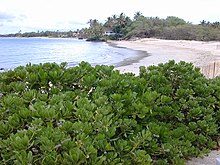



Tropical vegetation is any vegetation in tropical latitudes. Plant life that occurs in climates that are warm year-round is in general more biologically diverse than in other latitudes. Some tropical areas may receive abundant rain the whole year round, but others have long dry seasons which last several months and may vary in length and intensity with geographic location. These seasonal droughts have a great impact on the vegetation, such as in the Madagascar spiny forests.[1]
Rainforest vegetation is categorized by five layers. The top layer being the upper tree layer. Here you will find the largest and widest trees in all the forest. These trees tend to have very large canopy's so they can be fully exposed to sunlight. A layer below that is the middle tree layer. Here you will find more compact trees and vegetation. These trees tend to be more skinny as they are trying to gain any sunlight they can. The third layer is the lower tree area. These trees tend to be around five to ten meters high and tightly compacted. The trees found in the third layer are young trees trying to grow into the larger canopy trees. The fourth layer is the shrub layer beneath the tree canopy. This layer is mainly populated by sapling trees, shrubs, and seedlings. The fifth and final layer is the herb layer which is the forest floor. The forest floor is mainly bare except for various plants, mosses, and ferns. The forest floor is much more dense than above because of little sunlight and air movement.[2]
Plant species native to the tropics found in tropical ecosystems are known as tropical plants. Some examples of tropical ecosystems are the Guinean Forests of West Africa, the Madagascar dry deciduous forests and the broadleaf forests of the Thai highlands and the El Yunque National Forest in Puerto Rico.
- ^ 2006-01-13, Sciencedaily: Deep-rooted Plants Have Much Greater Impact On Climate Than Experts Thought
- ^ Park, Chris (2002). Tropical Rainforest. New York: Routledge. pp. 17-18. ISBN 0-415-06238-1.